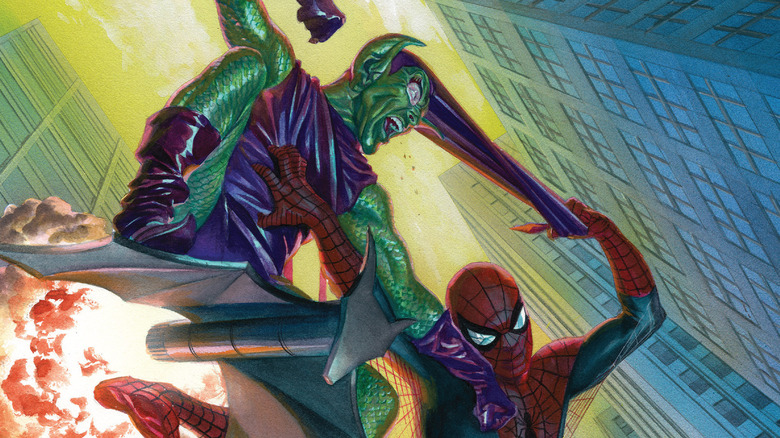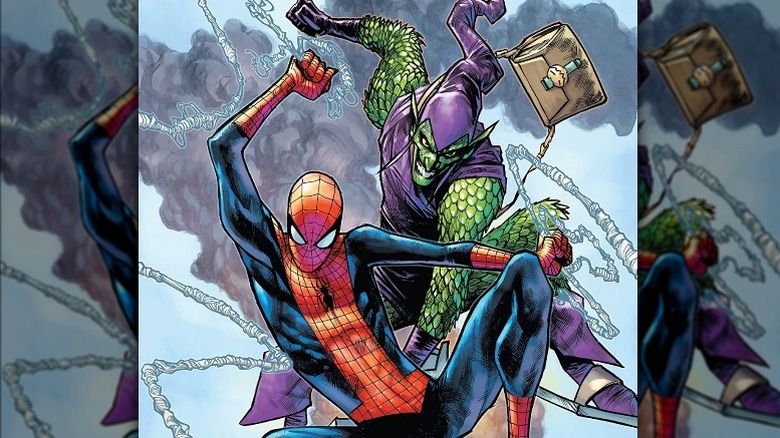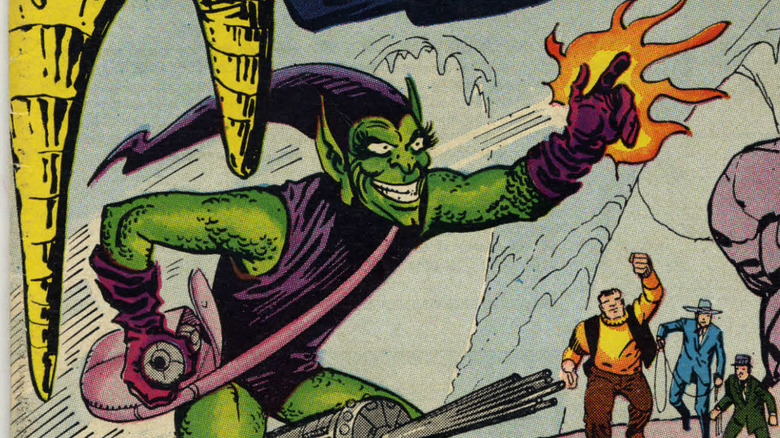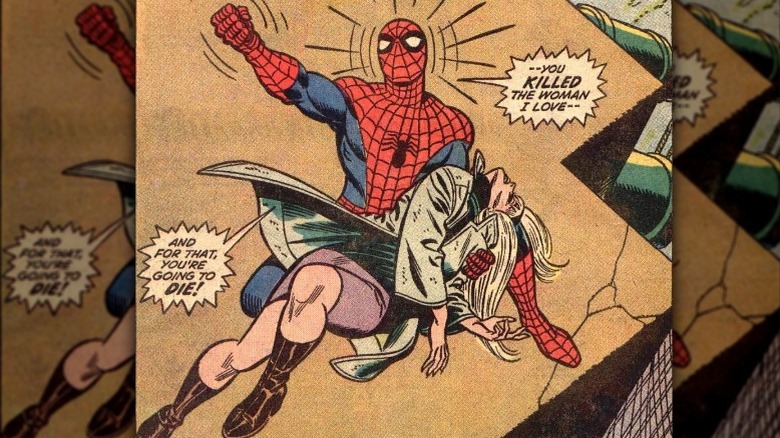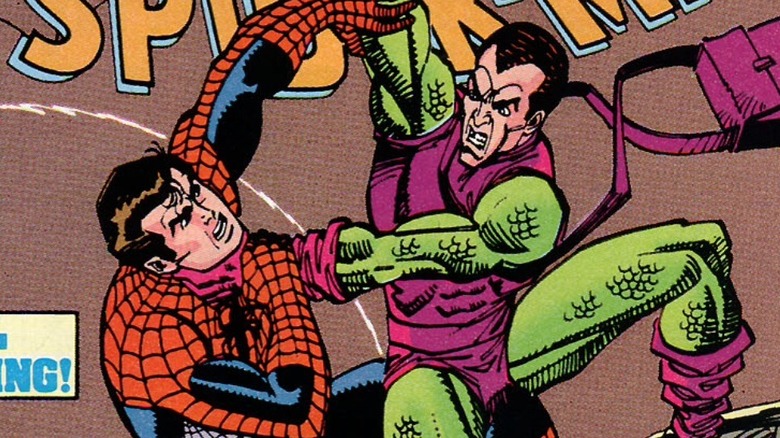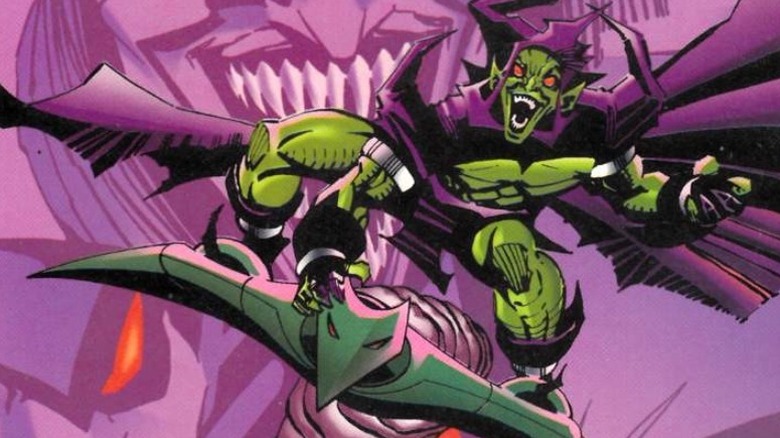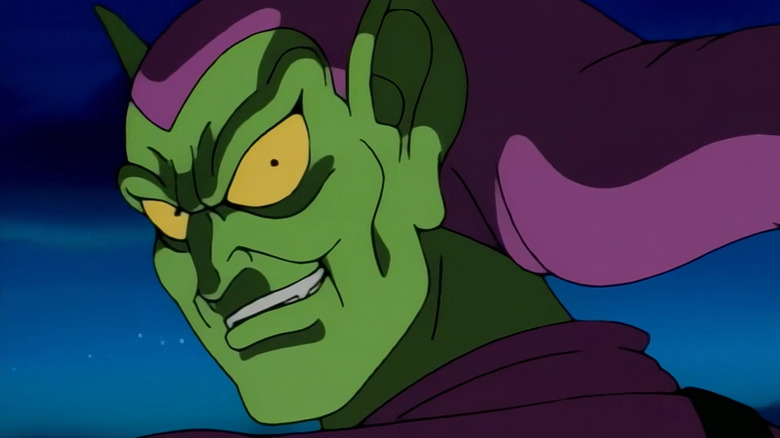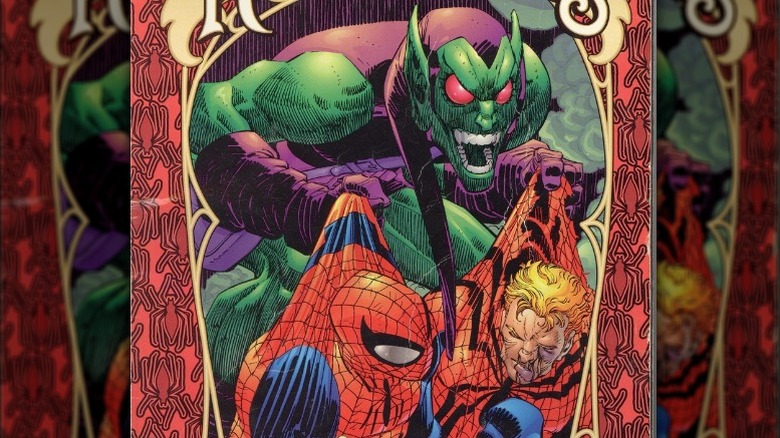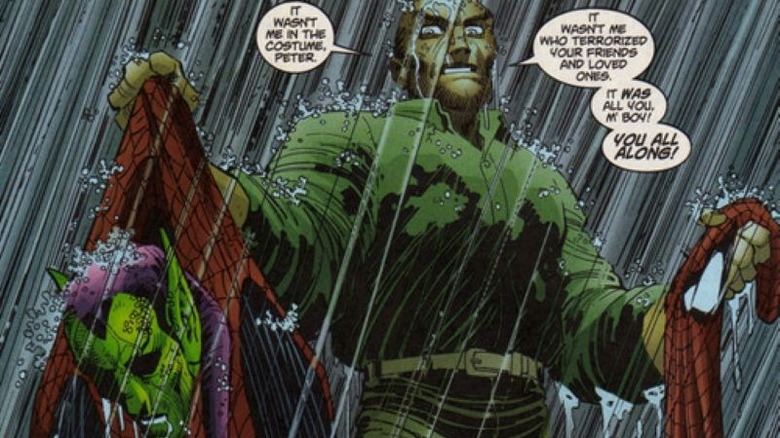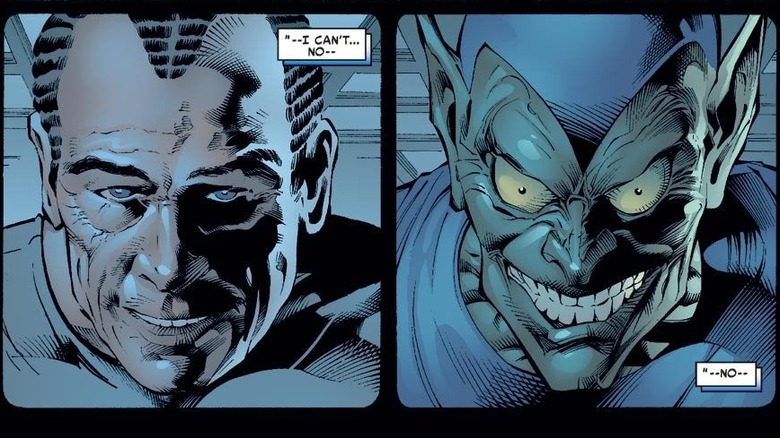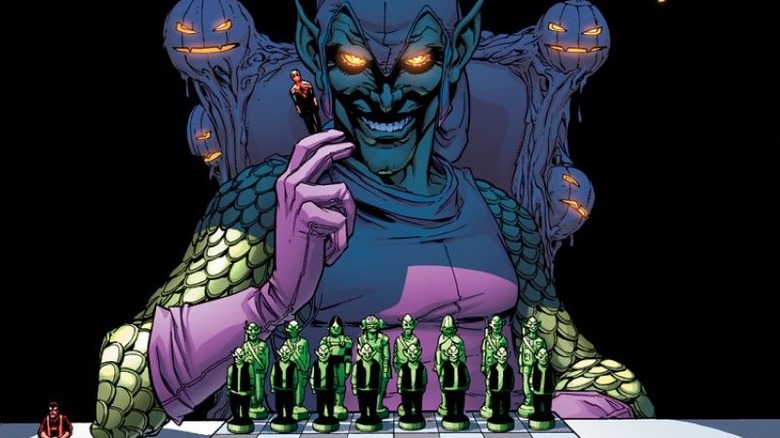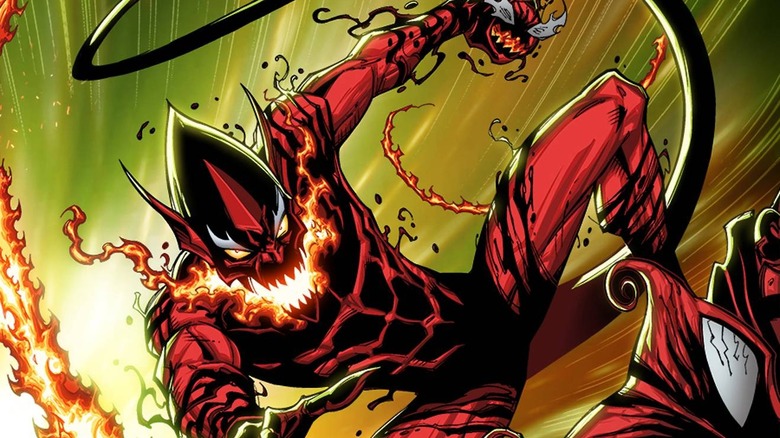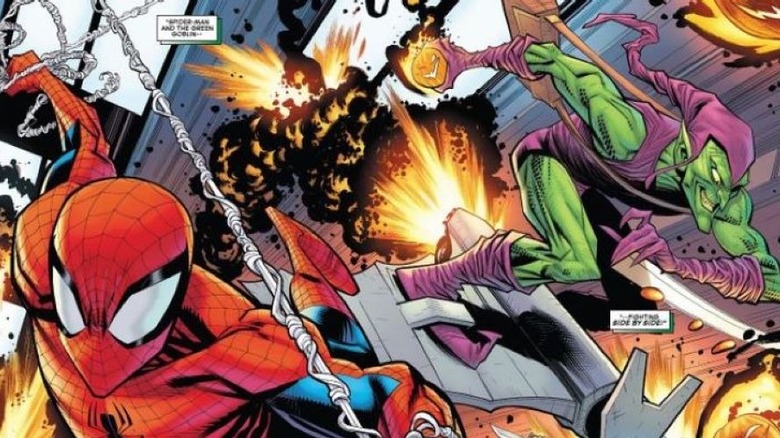Spider-Man's History With The Green Goblin Explained
Among all of Spider-Man's fearsome foes, few could claim to have done as much damage to the wall-crawler's superhero career and personal life as Norman Virgil Osborn, the first (and undoubtedly worst) Green Goblin.
Osborn wasn't even the first supervillain that Spider-Man ever tangled with in his own series. That dubious distinction belongs to the Chameleon, who locked horns with the web-slinger in 1963's "Amazing Spider-Man" #1. Ask any Spider-Man fan to name who they think his archenemy is, though, and Osborn will doubtlessly raise his nefarious, cornrowed head. Like the Kingpin, the Green Goblin has, for the most part, been able to maintain the facade of being a legitimate businessman. At one point, he even fooled the entire United States into effectively making him the nation's top cop. However, Osborn's single-minded obsession with his hated foe has proven to be the single constant thing in his life and career — and on multiple occasions, he has gone out of his way to fill the friendly neighborhood superhero's life with nigh-endless misery.
From killing Peter Parker's girlfriend to corrupting his best friend to making him doubt whether he's even a real person, the Green Goblin's countless anti-Spidey schemes have cemented his reputation in Spider-Man's rogues gallery as one of his greatest foes, if not the greatest of all. This is the complex and tragic history of Spider-Man and the Green Goblin, explained.
Planting the seeds of an eternal rivalry
The Green Goblin made his explosive debut in 1964's "Amazing Spider-Man" #14. The brainchild of writer Stan Lee and artist Steve Ditko, the Green Goblin was hyperbolically — and rather prophetically — advertised as "the most sinister, most dangerous foe Spidey's ever fought."
In their first encounter, the web-slinger fights his emerald-clad enemy and the criminal trio known as the Enforcers on a fake movie set, after Spider-Man was tricked into thinking that they were shooting a Hollywood blockbuster. Their tussle eventually brings them to a cave with an unexpected occupant: none other than the Incredible Hulk, who nearly cleans Spider-Man's clock as the Green Goblin watches from a distance. The battle ends with Spider-Man capturing the Enforcers, while the Green Goblin flies away. In a nice touch of synchronicity, the Green Goblin ended up being Spider-Man's very first cinematic villain, in the 2002 film "Spider-Man."
Interestingly, the seeds of the Green Goblin's emergence were planted by the devil himself. 2021's "Amazing Spider-Man" vol. 5 #72 revealed that Norman Osborn actually owes his tremendous fortune and success to a literal deal with the Prince of Darkness himself, Mephisto. While Osborn receives what he asked Mephisto for, the price is revealed to be the soul of his son, Harry. It's worth noting that this took place before Osborn ingested the Goblin formula that created his villainous persona — meaning that even without the chemical corruption, there had always been darkness hidden in Osborn's soul.
Who was the Green Goblin really supposed to be?
Considering the Green Goblin's eventual significant role in the Spider-Man mythos, it may come as a shock to some that when Stan Lee and Steve Ditko created him, they weren't even sure who he was supposed to be. In fact, the character of Norman Osborn wouldn't even make his official named debut in the comics until two years after the Green Goblin first showed up, in 1966's "Amazing Spider-Man" #37. That said, some fans believe that Ditko actually drew Osborn in a few panels in the comics before his formal introduction (per The Green Goblin's Hideout). Perhaps even more surprising, though, is the possibility that the Green Goblin's secret identity may have caused the late, legendary comic book duo to fall apart.
As ComicBook.com reports, Lee appeared at a panel at Nashville's Wizard World 2017. There, he shared his thoughts on what may have caused him and Ditko to end their collaboration. "I had a big argument with Steve Ditko, who was drawing the strip at the time," revealed Lee. "When we had to reveal the identity of the Green Goblin, I wanted him to turn out to be the father of Harry Osborn, and Steve didn't like that idea." Per Lee, Ditko allegedly wanted it to be a character that readers were completely unfamiliar with, offering a pragmatic (if somewhat undramatic) reason: "[Ditko] said 'Well, in real life, the bad guy doesn't always turn out to be someone you've known.'"
The death of Gwen Stacy: Who truly killed her?
Out of all the terrible consequences of Spider-Man crossing paths with the Green Goblin, perhaps nothing comes close to the death of Gwen Stacy, the person many consider to be Peter Parker's one true love. In 1973's "Amazing Spider-Man" #121, the Green Goblin — who at this point is well aware of Spider-Man's secret identity — kidnaps Gwen and takes her to the George Washington Bridge (illustrated in the comic book as the Brooklyn Bridge). As Spider-Man fails to quickly put an end to their skirmish, the Green Goblin takes the opportunity to throw Gwen (depicted as unconscious) off the bridge.
Forced to make a split-second decision, Spider-Man throws a webline and snags Gwen with it, with tragic results. Initially self-congratulatory after what he thought was a daring save, it quickly dawns upon Spider-Man that his beloved girlfriend was no longer breathing. The heartbroken web-slinger then swears to kill the villain with his own hands. In the next issue, Spider-Man and the Green Goblin find themselves locked in brutal combat, which concludes when Osborn impales himself with his own glider.
While the Green Goblin was doubtlessly responsible for Gwen's predicament, a question lingered in fans' minds: Did Peter actually kill Gwen with his webline? Unfortunately, the letters column of "Amazing Spider-Man" #125 (via ComicBook.com) confirms this: "It saddens us to have to say that the whiplash effect she underwent when Spidey's webbing stopped her so suddenly was, in fact, what killed her."
From the father to the son
When Norman Osborn was temporarily taken off the board following his "death" in "Amazing Spider-Man" #122, his son, Harry, took over for him. This added another layer of tragedy to the dynamic between the Goblin and the Spider, as Harry was Peter Parker's best friend.
Unbeknownst to Peter, Harry actually witnessed his father's death, and hastily took action to recover his body before the authorities could peg him as the Green Goblin. On top of this, Harry had a sneaking suspicion that there was a strong link between his best friend and the superhero of whom he frequently took photos for the Daily Bugle. Harry confirms this in 1974's "Amazing Spider-Man" #135 after finding Peter's costume in his drawer. Harry suits up as the Green Goblin, and comes to blows with Spider-Man two issues later in a convoluted plan to kill Peter and his loved ones. However, despite blurting out Spider-Man's secret identity, the authorities who apprehended him dismiss his allegations, thinking that they were nothing but insane ramblings.
Harry fights Peter a few more times as the Green Goblin. Their antagonistic relationship reaches a heartbreaking end in 1993's "Spectacular Spider-Man" #200. Harry traps Peter in a burning building, only to come to his senses at the last minute and return to save his old friend. The strain of his buzzer-beating heroism proves to be too much — and Harry dies on an ambulance stretcher holding Peter's hand, leaving the web-slinger in silent grief.
The other Green Goblins
Aside from Norman and Harry Osborn, others have fallen prey to the effects of the Goblin serum — whether accidentally or intentionally — and assumed the mantle of the Green Goblin or created a new identity for themselves. There was research assistant Nels Van Adder, who mutated into the Proto-Goblin after willingly becoming a guinea pig for an early version of the Goblin formula. There's also Lily Hollister, a politician's daughter and Harry's girlfriend who became the villain known as Menace. Even Harry's former psychiatrist, Bart Hamilton, temporarily assumed the mantle of the Green Goblin — an act that quickly leads to Hamilton's own explosive demise.
Among all the others who were exposed to the formula and donned the Green Goblin's mask, perhaps the most noteworthy is Phil Urich. The nephew of veteran Daily Bugle journalist Ben Urich, Phil was inadvertently exposed to the Goblin formula while helping his uncle put together a book about Norman Osborn's history and crimes. 1995's "Green Goblin" #1 showed Phil's accident, as well as the events that led him to become the first heroic Green Goblin. However, Phil's superhero career was not without its downsides; aside from the usual challenges of balancing dual lives, Phil had to deal with recurring nightmares that featured past Green Goblins. The title would run for 13 issues before Phil lost his powers and equipment, prompting him to retire the mantle of the Goblin.
Sidelined in the '90s animated series
For many young fans in the 1990s, "Spider-Man: The Animated Series" served as their introduction to the web-slinger and his world. However, one of its most significant departures from the source material was the fact that it introduced the Hobgoblin (the Jason Macendale version, voiced by none other than Mark Hamill) before the Green Goblin (portrayed by Neil Ross).
In the comics, Roderick Kingsley became the Hobgoblin after stumbling upon one of the Green Goblin's secret weapons stashes. Meanwhile, in this continuity, Macendale became the Hobgoblin partly at the behest of Osborn, who provided him with high-tech equipment in exchange for completing an assassination job. Osborn donned the Green Goblin costume later on in the series, proving to be as much of a thorn in Spider-Man's side as his comic book counterpart.
Interestingly enough, this major modification in the Hobgoblin-Green Goblin dynamic was not brought about by a desire to put a new twist on the characters' classic origins. Speaking with The Marvel Animation Age, writer-producer John Semper, Jr. revealed that a previously fired writer had "for some strange reason known only to him," chosen to feature the Hobgoblin as one of Spider-Man's early antagonists on the show. This decision led series executive producer Avi Arad to sink "millions" into a deal with toy manufacturing company Toy Biz, which had already prepared a Hobgoblin action figure for the first wave of the show's companion toy line. As such, Semper's hands were tied when he took over the animated project, with both he and Arad "cursing the very existence of" the previous scribe over "what a dumb decision it had been."
Clone confusion
If bringing about the death of Gwen Stacy can be considered the Green Goblin's most terrible act, then making Peter Parker doubt his own existence is perhaps a close second. As it turns out, Norman Osborn was the mastermind behind the Clone Saga, a massive crossover story across the Spider-Man books that started in 1994's "Web of Spider-Man" #117.
The Clone Saga saw the return of Ben Reilly, Peter's formerly unnamed clone from 1975's "Amazing Spider-Man" #149. In one of the story arc's pivotal moments, it's revealed that Ben was actually the real Spider-Man, and that the Peter Parker readers had been following for nearly two decades was actually a clone. This led to a major change in the Spider-books, with Ben taking over as the "one, true" Spider-Man for a period of time. However, there were still hints of a sinister mastermind who orchestrated this catastrophe in Spider-Man's life — and the first clue readers got was a shadow in "Amazing Spider-Man" #412. Six issues later, in "Amazing Spider-Man" #418, the chief architect was revealed to be Osborn, who had survived his brush with death years ago.
The Clone Saga concluded in "Spider-Man" #75, as both Peter and Ben faced off against Osborn. In a tragic turn of events, Ben meets the business end of Osborn's glider and falls from the top of the Daily Bugle, eventually dying (albeit temporarily) in Peter's arms. This revives the rivalry between Peter and Osborn, setting the stage for future clashes.
Peter Parker: The Goblin's successor?
As the old adage goes, "If you can't beat 'em, join 'em." It seems like Norman Osborn took this to heart and added his own sinister twist to it, as he once tried to make Peter Parker his Goblin heir. That's right: The Green Goblin, at one point, felt that the best person to continue his legacy of evil was none other than his hated foe Spider-Man.
In the issues prior to 2001's "Amazing Spider-Man" vol. 2 #25, the Green Goblin reemerges to terrorize New York City, as Peter begins experiencing extreme fatigue and nightmares involving both Osborn and Gwen Stacy. It would later be revealed that Peter was actually suiting up as the Goblin while he was asleep, and was completely unaware of his activities disguised as Osborn's hideous alter-ego.
Eventually, Osborn reveals the truth to Peter: the wall-crawler had actually been exposed to a hallucinogenic substance imbued with the Goblin Serum. The Green Goblin easily captures the disturbed superhero, and "Peter Parker: Spider-Man" vol. 1 #25 shows Osborn subjecting Peter to extreme mental and physical torture in Osborn's mansion, seemingly for weeks. However, despite Osborn's best efforts to brainwash Peter into "be[ing] an Osborn," Spider-Man successfully resists. Still, the Green Goblin counts this as a victory, leaving the nearly broken hero as he flies cackling into the stormy night.
The lies of Sins Past
One of the most horrific reveals in recent Spider-history was the supposed affair between Norman Osborn and Gwen Stacy. In the story arc called "Sins Past" (which started in "Amazing Spider-Man" #509), Peter Parker begins to discover a disturbing secret that Osborn, Gwen, and even his wife Mary Jane Watson kept from him for many years: Osborn and Gwen had a brief sexual relationship, which resulted in Gwen becoming pregnant with Osborn's children. As the story goes, Gwen secretly gave birth to them — twins named Sarah and Gabriel — while Osborn raised them believing that Peter was their father, and that he had abandoned them. Due to their unique lineage, the twins grew at an accelerated rate, reaching adulthood in only a matter of years. For a time, they tried their best to kill Spider-Man, until they discovered the truth about their parentage.
Unsurprisingly, "Sins Past" quickly became one of the most hated stories in Spider-Man's history (via GamesRadar), which was why many fans breathed a sigh of relief when Nick Spencer retconned it in 2021's "Amazing-Spider-Man" vol. 5 #73. Following the revelation that mystery villain Kindred was actually Sarah and Gabriel's shared nom de guerre, an A.I. of Harry Osborn revealed to his father that the events of "Sins Past" were all lies orchestrated by Mysterio and Mendel Stromm. In reality, the twins were lab-raised clones, and Osborn was merely mentally manipulated into believing that he had an affair with Gwen.
Norman Osborn versus the Superior Spider-Man
When Doctor Otto Octavius attempted to escape certain death by taking over Peter Parker's body, he was bombarded by the hero's formative memories. This brought about a change of heart in the former villain, who swore that he would carry on in Peter's stead as the "Superior Spider-Man." Unfortunately, assuming Spider-Man's life also means dealing with both the good and the bad parts of it — and as far as the latter goes, few things come close to the unbridled evil of Norman Osborn.
In "Superior Spider-Man" vol. 1 #14, Osborn grows his army as the newly christened Goblin King. The villain eventually discovers the Superior Spider-Man's secret, and decides to offer Otto a deal in "Superior Spider-Man" #27.NOW: Partner up with him and become his second-in-command, and they can rule the city together. Unsurprisingly, Otto says no to this, leading to an all-out war on the streets of New York between the two vicious opponents. A time-displaced Spider-Man 2099 is even forced to lend a hand to Otto, but they turn out to be no match for Osborn's mechanical Goblin-Slayers.
In a last-ditch attempt to save everything he holds dear, Otto willingly relinquishes control of Peter's body to a surviving fragment of his consciousness in "Superior Spider-Man" vol. 1 #30. In doing so, Otto concedes that Peter is the true superior Spider-Man, enabling the hero to resume his battle against Osborn and save the day once more.
From green to red: the Red Goblin
Some things just go well together, like chocolate and peanut butter or milk and cookies. Others make for interesting combinations with horrific results, like a power-mad villain on the brink of desperation and a murderous symbiote.
When Norman Osborn gets his hands on the Carnage symbiote, he makes the decision to bond with it in order to regain the powers he had previously lost. Their abhorrent union creates the Red Goblin, a demonic-looking entity that immediately wreaks havoc upon New York City. Despite receiving help from Spider-themed allies, Spider-Man proves to be at a severe disadvantage against the merger of his two most dangerous enemies.
"Amazing Spider-Man" #800 sees the conclusion of the brutal battle between Spider-Man and the Red Goblin. While Spider-Man succeeds in bringing down the Carnage-empowered Osborn, his victory does not come without a cost. Peter's longtime friend Flash Thompson, also known as the superhero Agent Anti-Venom, ends up sacrificing his life to enable Peter (who had temporarily merged with the Venom symbiote) to deliver the final blow to Osborn. The unhinged businessman frantically tries to bond once more with the Carnage symbiote, but gets caught in an explosion that severely affects his brain. This leads to Osborn being confined in an asylum, his sanity seemingly lost for good.
Spider-Man and the Green Goblin: An unexpected team-up
With all the bad blood between Spider-Man and the Green Goblin, it may come as a surprise that on at least two occasions, the eternal enemies found themselves fighting side by side.
In 1990's "Web of Spider-Man" vol. 1 #66, Spider-Man comes to the Molten Man's aid after the latter asks him for help against the powerful gangster boss Tombstone. A reformed villain, the Molten Man was being blackmailed by Tombstone, seeking his compliance in a break-in at Harry Osborn's chemical plant to steal drug reagents. In the ensuing melee, the web-slinger and his gold-skinned former foe find an unexpected ally in Harry as the Green Goblin, who fights alongside them to protect his building.
2020's "Amazing Spider-Man" vol. 5 #49, on the other hand, shows the original Green Goblin Norman Osborn reclaiming his villainous mantle. Forced to ally with Spider-Man to survive an onslaught of enemies, the web-slinger is shocked (and disgusted) when he realizes that they work well together. And while Osborn predictably (albeit unsuccessfully) betrays Peter, it's still worth noting that these two men with boundless hate for each other may actually have more in common than Spider-Man would like to admit.
